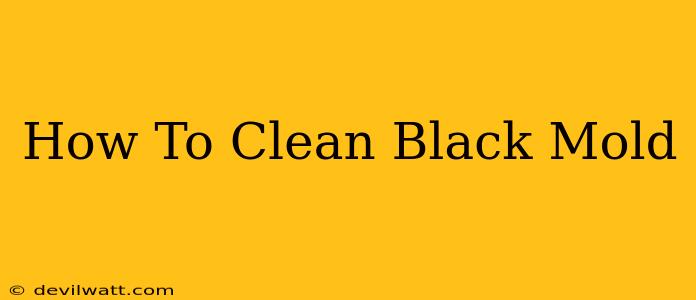Black mold, or Stachybotrys chartarum, is a type of mold that can cause serious health problems if left untreated. It's often found in damp, humid areas of the home, and its presence is easily identified by its distinctive black, slimy appearance. This guide will walk you through the safe and effective removal of black mold, but remember: for extensive or large infestations, professional help is crucial.
Understanding the Dangers of Black Mold
Before tackling black mold removal, it's essential to understand the potential health risks. Inhaling black mold spores can trigger allergic reactions, respiratory problems (including asthma exacerbations), and in some cases, more severe health issues. Never attempt to clean extensive mold infestations yourself. If you have concerns about your health or the extent of the mold, consult a medical professional and a mold remediation specialist.
Symptoms of Black Mold Exposure:
- Respiratory Issues: Coughing, wheezing, shortness of breath
- Allergies: Runny nose, sneezing, itchy eyes
- Skin Irritation: Rashes, redness
- Headaches and Fatigue: Persistent headaches and unusual tiredness
Preparing for Black Mold Removal:
Safety First! Cleaning black mold requires protective gear to prevent spore inhalation and skin contact. Always wear:
- N95 Respirator: This is essential to protect your lungs from mold spores.
- Rubber Gloves: Protect your skin from contact.
- Eye Protection: Safety goggles will prevent spores from entering your eyes.
- Protective Clothing: Long sleeves and pants will help to minimize skin exposure.
Gather Your Supplies:
- HEPA Vacuum: A high-efficiency particulate air (HEPA) vacuum is critical for removing mold spores effectively. Regular vacuums are not sufficient.
- Scrub Brushes: Stiff-bristled brushes are needed to scrub affected surfaces.
- Mold Killer: Choose a product specifically designed for mold and mildew removal. Always follow the manufacturer's instructions carefully. A solution of bleach and water (1 part bleach to 10 parts water) is sometimes used, but only on hard, non-porous surfaces. Bleach is corrosive and can damage some surfaces.
- Spray Bottle: For applying the mold killer.
- Protective Plastic Sheeting: Cover surrounding areas to prevent mold spread.
- Dehumidifier: After cleaning, a dehumidifier will help prevent future mold growth.
Steps for Cleaning Black Mold:
- Assess the Situation: Determine the size and extent of the mold infestation. If it's larger than 10 square feet, call a professional.
- Isolate the Area: Contain the affected area with plastic sheeting to prevent mold spores from spreading.
- Protect Yourself: Put on all your protective gear before beginning.
- Vacuum the Area: Thoroughly vacuum the affected area using your HEPA vacuum to remove loose mold spores.
- Apply Mold Killer: Follow the manufacturer's instructions carefully for application and dwell time. Never mix different cleaning products.
- Scrub the Surface: Use a stiff-bristled brush to scrub the affected area, removing all visible mold.
- Rinse Thoroughly: Rinse the surface with clean water.
- Dry Completely: Ensure the area is completely dry to prevent mold regrowth. Use fans or a dehumidifier to accelerate drying.
- Dispose of Materials: Carefully dispose of all contaminated materials according to local regulations. This usually involves double bagging and discarding in sealed containers.
- Monitor the Area: Keep an eye on the area for signs of mold regrowth.
Preventing Black Mold Growth:
- Maintain proper ventilation: Ensure good airflow in your home, especially in bathrooms and kitchens.
- Control humidity: Use a dehumidifier to keep humidity levels low.
- Repair leaks promptly: Fix any leaks or water damage immediately.
- Clean regularly: Regularly clean and disinfect areas prone to mold growth.
Disclaimer: This guide provides general information. Always consult with professionals for extensive mold infestations or if you have health concerns related to mold exposure. Improper mold remediation can worsen the problem and lead to health risks. The safety and well-being of yourself and your family should always be your top priority.

